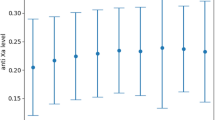Abstract
Background
Myocardial injury after aneurysmal subarachnoid hemorrhage (aSAH) is associated with poor outcomes. Delayed cerebral ischemia (DCI) is also a complication of aSAH. We sought to determine whether (1) DCI could be predicted by demographics, aSAH severity/aneurysm location, or aSAH-associated myocardial injury (SAHMI), and (2) DCI is associated with increased mortality after aSAH.
Methods
Prospective longitudinal study of 149 aSAH subjects with definitive DCI evaluation, age 18–75 years, Hunt and Hess (HH) ≥ 3, and/or Fisher ≥ 2, and admitted to the Neurovascular ICU. DCI was defined by the presence of neurological deterioration accompanied by evidence of abnormal cerebral blood flow.
Results
Subjects were 48% DCI(+) and 52% DCI(−). DCI(+) subjects had more severe aSAH [HH (P = 0.002), Fisher (P = 0.004), admission Glasgow Coma Scale (P = 0.018)]. More DCI(+) subjects had pulmonary congestion than DCI(−) subjects (63 vs. 39%, P = 0.003). On echocardiogram, cardiac output (CO, liters per minute [LPM]) was significantly higher in DCI(+) than in DCI(−) subjects (6 ± 2 vs. 5 ± 1 LPM; P = 0.015). Multivariate analysis identified CO and Fisher grade as independent predictors of DCI (P = 0.02, 0.019). For each 1 LPM increase in CO, the odds of DCI increased by 1.5 (95% CI: 1.1–2.1). Fisher grade 4 increased the odds of DCI by 6.5 compared to Fisher grade 2 (95% CI: 1.6–25.8). After controlling for Fisher grade, CO remained an independent predictor of DCI (P = 0.02). Three-month mortality rate was not significantly different between DCI groups, P = 0.786.
Conclusion
Elevated CO and Fisher grade are predictors of DCI after aSAH. However, prevention of DCI may not decrease mortality.
Similar content being viewed by others
Notes
Student’s t-test results were consistent with Mann–Whitney U-test results.
References
King JT Jr. Epidemiology of aneurysmal subarachnoid hemorrhage. Neuroimaging Clin N Am. 1997;7:659–68.
Wiebers DO, Torner JC, Meissner I. Impact of unruptured intracranial aneurysms on public health in the United States. Stroke. 1992;23:1416–9.
Bonita R, Thomson S. Subarachnoid hemorrhage: epidemiology, diagnosis, management, and outcome. Stroke. 1985;16:591–4.
Hop JW, Rinkel GJ, Algra A, van Gijn J. Case-fatality rates and functional outcome after subarachnoid hemorrhage: a systematic review. Stroke. 1997;28:660–4.
Ingall T, Asplund K, Mahonen M, Bonita R. A multinational comparison of subarachnoid hemorrhage epidemiology in the WHO MONICA stroke study. Stroke. 2000;31:1054–61.
Hravnak M, Frangiskakis JM, Crago EA, et al. Elevated cardiac troponin I and relationship to persistence of electrocardiographic and echocardiographic abnormalities after aneurysmal subarachnoid hemorrhage. Stroke. 2009;40:3478–84.
Crago EA, Kerr ME, Kong Y, et al. The impact of cardiac complications on outcome in the SAH population. Acta Neurol Scand. 2004;110:248–53.
Frontera JA, Fernandez A, Schmidt JM, et al. Defining vasospasm after subarachnoid hemorrhage: what is the most clinically relevant definition? Stroke. 2009;40:1963–8.
Carrera E, Schmidt JM, Oddo M, et al. Transcranial Doppler for predicting delayed cerebral ischemia after subarachnoid hemorrhage. Neurosurgery. 2009;65:316–23. discussion 23-4.
Wintermark M, Thiran JP, Maeder P, Schnyder P, Meuli R. Simultaneous measurement of regional cerebral blood flow by perfusion CT and stable xenon CT: a validation study. AJNR Am J Neuroradiol. 2001;22:905–14.
Carrera E, Schmidt JM, Oddo M, et al. Transcranial Doppler ultrasound in the acute phase of aneurysmal subarachnoid hemorrhage. Cerebrovasc Dis. 2009;27:579–84.
Claassen J, Bernardini GL, Kreiter K, et al. Effect of cisternal and ventricular blood on risk of delayed cerebral ischemia after subarachnoid hemorrhage: the Fisher scale revisited. Stroke. 2001;32:2012–20.
Hop JW, Rinkel GJ, Algra A, van Gijn J. Initial loss of consciousness and risk of delayed cerebral ischemia after aneurysmal subarachnoid hemorrhage [see comment]. Stroke. 1999;30:2268–71.
Vergouwen MD, van Geloven N, de Haan RJ, Kruyt ND, Vermeulen M, Roos YB. Increased cortisol levels are associated with delayed cerebral ischemia after aneurysmal subarachnoid hemorrhage. Neurocrit Care. 2010;12:342–5.
Dankbaar JW, Rijsdijk M, van der Schaaf IC, et al. Relationship between vasospasm, cerebral perfusion, and delayed cerebral ischemia after aneurysmal subarachnoid hemorrhage. Neuroradiology. 2009;51:813–9.
van der Bilt IA, Hasan D, Vandertop WP, et al. Impact of cardiac complications on outcome after aneurysmal subarachnoid hemorrhage: a meta-analysis. Neurology. 2009;72:635–42.
Rijsdijk M, van der Schaaf IC, Velthuis BK, Wermer MJ, Rinkel GJ, Rinkel GJE. Global and focal cerebral perfusion after aneurysmal subarachnoid hemorrhage in relation with delayed cerebral ischemia. Neuroradiology. 2008;50:813–20.
van der Schaaf I, Wermer MJ, van der Graaf Y, et al. CT after subarachnoid hemorrhage: relation of cerebral perfusion to delayed cerebral ischemia. Neurology. 2006;66:1533–8.
Hijdra A, van Gijn J, Nagelkerke NJ, Vermeulen M, van Crevel H. Prediction of delayed cerebral ischemia, rebleeding, and outcome after aneurysmal subarachnoid hemorrhage. Stroke. 1988;19:1250–6.
Ramappa P, Thatai D, Coplin W, et al. Cardiac troponin-I: a predictor of prognosis in subarachnoid hemorrhage. Neurocrit Care. 2008;8:398–403.
Schuiling WJ, Algra A, de Weerd AW, Leemans P, Rinkel GJ, Rinkel GJE. ECG abnormalities in predicting secondary cerebral ischemia after subarachnoid haemorrhage. Acta Neurochir. 2006;148:853–8. discussion 8.
Naidech AM, Kreiter KT, Janjua N, et al. Cardiac troponin elevation, cardiovascular morbidity, and outcome after subarachnoid hemorrhage. Circulation. 2005;112:2851–6.
Friedman JA, Pichelmann MA, Piepgras DG, et al. Pulmonary complications of aneurysmal subarachnoid hemorrhage. Neurosurgery. 2003;52:1025–31. discussion 31–32.
Frontera JA, Parra A, Shimbo D, et al. Cardiac arrhythmias after subarachnoid hemorrhage: risk factors and impact on outcome. Cerebrovasc Dis. 2008;26:71–8.
Frangiskakis JM, Hravnak M, Crago EA, et al. Ventricular arrhythmia risk after subarachnoid hemorrhage. Neurocrit Care. 2009;10:287–94.
Schutz H, Krack P, Buchinger B, et al. Outcome of patients with aneurysmal and presumed aneurysmal bleeding. A hospital study based on 100 consecutive cases in a neurological clinic. Neurosurg Rev. 1993;16:15–25.
Author information
Authors and Affiliations
Corresponding author
Rights and permissions
About this article
Cite this article
Yousef, K., Crago, E., Kuo, CW. et al. Predictors of Delayed Cerebral Ischemia After Aneurysmal Subarachnoid Hemorrhage: A Cardiac Focus. Neurocrit Care 13, 366–372 (2010). https://doi.org/10.1007/s12028-010-9408-4
Published:
Issue Date:
DOI: https://doi.org/10.1007/s12028-010-9408-4




